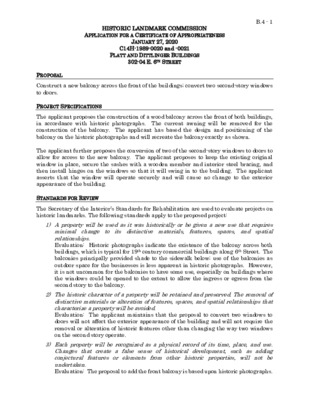B.4 - Platt and Dittlinger Buildings, 302-04 E. 6th Street — original pdf
Backup

HISTORIC LANDMARK COMMISSION APPLICATION FOR A CERTIFICATE OF APPROPRIATENESS B.4 - 1 JANUARY 27, 2020 C14H-1989-0020 and -0021 PLATT AND DITTLINGER BUILDINGS 302-04 E. 6TH STREET Construct a new balcony across the front of the buildings; convert two second-story windows to doors. PROPOSAL PROJECT SPECIFICATIONS The applicant proposes the construction of a wood balcony across the front of both buildings, in accordance with historic photographs. The current awning will be removed for the construction of the balcony. The applicant has based the design and positioning of the balcony on the historic photographs and will recreate the balcony exactly as shown. The applicant further proposes the conversion of two of the second-story windows to doors to allow for access to the new balcony. The applicant proposes to keep the existing original window in place, secure the sashes with a wooden member and interior steel bracing, and then install hinges on the windows so that it will swing in to the building. The applicant asserts that the window will operate securely and will cause no change to the exterior appearance of the building. STANDARDS FOR REVIEW The Secretary of the Interior’s Standards for Rehabilitation are used to evaluate projects on historic landmarks. The following standards apply to the proposed project: 1) A property will be used as it was historically or be given a new use that requires minimal change to its distinctive materials, features, spaces, and spatial relationships. Evaluation: Historic photographs indicate the existence of the balcony across both buildings, which is typical for 19th century commercial buildings along 6th Street. The balconies principally provided shade to the sidewalk below; use of the balconies as outdoor space for the businesses is less apparent in historic photographs. However, it is not uncommon for the balconies to have some use, especially on buildings where the windows could be opened to the extent to allow the ingress or egress from the second story to the balcony. 2) The historic character of a property will be retained and preserved. The removal of distinctive materials or alteration of features, spaces, and spatial relationships that characterize a property will be avoided. Evaluation: The applicant maintains that the proposal to convert two windows to doors will not affect the exterior appearance of the building and will not require the removal or alteration of historic features other than changing the way two windows on the second story operate. 3) Each property will be recognized as a physical record of its time, place, and use. Changes that create a false sense of historical development, such as adding conjectural features or elements from other historic properties, will not be undertaken. Evaluation: The proposal to add the front balcony is based upon historic photographs. B.4 - 2 4) Changes to a property that have acquired historic significance in their own right will be retained and preserved. Evaluation: The existing canopy proposed for removal is not historic; no other existing features on the building will be changed or removed. 5) Distinctive materials, features, finishes, and construction techniques or examples of craftsmanship that characterize a property will be preserved. Evaluation: N/A 6) Deteriorated historic features will be repaired rather than replaced. Where the severity of deterioration requires replacement of a distinctive feature, the new feature will match the old in design, color, texture, and, where possible, materials. Replacement of missing features will be substantiated by documentary and physical evidence. Evaluation: N/A 7) Chemical or physical treatments, if appropriate, will be undertaken using the gentlest means possible. Treatments that cause damage to historic materials will not be used. Evaluation: N/A 8) Archeological resources will be protected and preserved in place. If such resources must be disturbed, mitigation measures will be undertaken. Evaluation: N/A 9) New additions, exterior alterations, or related new construction will not destroy historic materials, features, and spatial relationships that characterize the property. The new work will be differentiated from the old and will be compatible with the historic materials, features, size, scale and proportion, and massing to protect the integrity of the property and its environment. Evaluation: The proposed changes will not alter the historic character of the building and will reconstruct a missing architectural element. 10) New additions and adjacent or related construction will be undertaken in such a manner that, if removed in the future, the essential form and integrity of the historic property and its environment would be unimpaired. Evaluation: The proposed work is potentially reversible. The project meets the applicable standards. COMMITTEE RECOMMENDATIONS The Committee had reservations about the placement of the balcony vis-à-vis the building façade, and the obstruction of historic features on the building. The Committee further had reservations about how the conversion of the windows to doors would work without incurring damage to the sashes and frames. STAFF RECOMMENDATION If the Commission is satisfied with the materials and justification provided by the applicant, then staff recommends approval of the proposal. The reconstruction of the missing balcony is an excellent step towards restoring the historic appearance of this building, and is in keeping with the general principles for accurate restoration of missing historic features. Staff shares the Committee’s concerns about the conversion of the windows to doors, but after conversations with the applicant’s architect, can see how this can work successfully with additional bracing on the inside of the windows.